Unraveling the Depths of Intense Focus
Hyperfixation is a fascinating cognitive phenomenon characterized by an intense, prolonged concentration on a specific activity or subject. While often associated with neurodivergent populations, it is a behavior that can affect anyone, manifesting in various forms with both beneficial and challenging consequences. In this article, we explore what hyperfixation entails, how it differs from related concepts, its roots in neurological and psychological factors, and strategies to manage it effectively.
Defining Hyperfixation and Its Core Characteristics

What is hyperfixation?
Hyperfixation is an intense and prolonged focus on a specific activity, subject, or object. It often consumes a large part of a person's attention and can last from a few minutes to several months or even years. During this state, individuals become deeply engaged, often losing awareness of their surroundings and neglecting responsibilities or basic needs like eating, sleeping, and self-care.
Signs and symptoms of hyperfixation
Common signs of hyperfixation include losing track of time, ignoring others, neglecting personal needs, and struggling to switch focus from the chosen activity. People may become so absorbed that they tune out environmental stimuli or social interactions, often feeling energized or excited while engaged. They may also experience frustration or guilt after realizing how much time or energy they've spent.
Duration and intensity of hyperfixation
Hyperfixations can vary greatly in length and intensity. Some may last only a few minutes, while others can dominate someone's life for months or years. The intensity often relates to how much the activity or interest activates the brain’s reward system, especially in cases like ADHD, where dopamine regulation influences focus. Longer fixations tend to be more disruptive, impacting daily routines and responsibilities.
Effects on daily life
While hyperfixation can foster deep learning, creativity, and skill development, it can also interfere with essential aspects of everyday life. It may cause missed deadlines, neglected relationships, and health issues from prolonged inactivity or neglect of personal needs. If unmanaged, hyperfixation can lead to emotional distress, burnout, and social withdrawal.
Understanding hyperfixation, especially its profound influence on focus and behavior, is important for managing it effectively. Strategies such as setting time limits, establishing routines, and seeking support can help balance passions with daily responsibilities, promoting overall well-being.
Distinguishing Hyperfixation from Hyperfocus and Special Interests
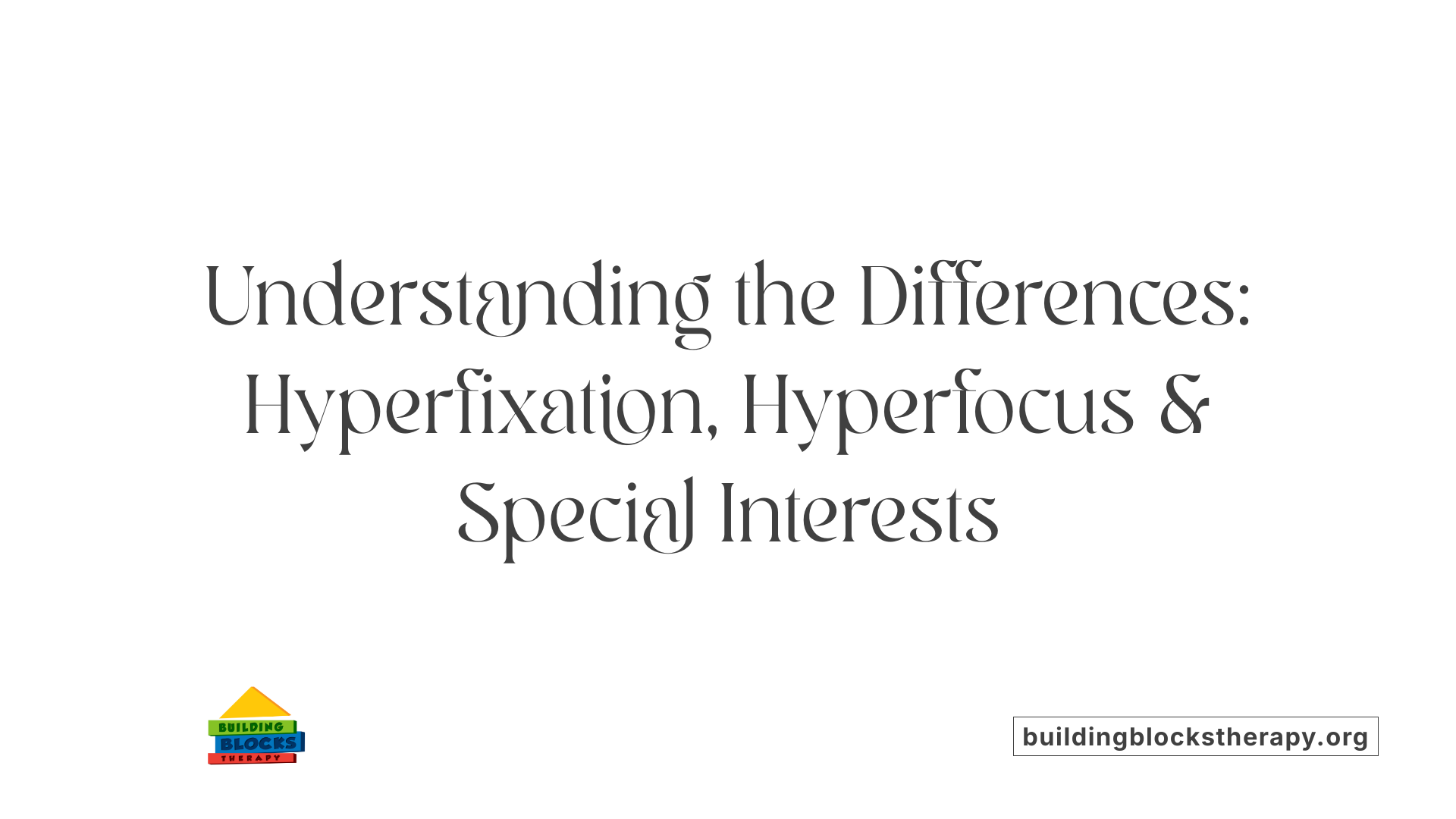
How does hyperfixation differ from hyperfocus and special interests?
Hyperfixation, hyperfocus, and special interests are all about intense concentration, but they vary in duration, purpose, and impact.
Hyperfocus is a short-term, highly immersive state of concentration on a task or activity. Typically seen in individuals with ADHD, it can last from a few minutes to several hours. During hyperfocus, a person might become completely absorbed, ignoring their surroundings or other responsibilities. While this can boost productivity temporarily, it often leads to neglecting basic needs like eating or sleeping.
Hyperfixation, on the other hand, is a more persistent, long-lasting form of intense focus. It can last for months or even years, especially in neurodivergent individuals such as those with ADHD or autism. Those experiencing hyperfixation often lose track of time, neglect responsibilities, and become detached from social interactions due to their dedication to a particular activity, object, or subject.
Special interests are passionate pursuits that tend to be ongoing parts of a person’s identity, especially common in autism. They are characterized by deep, enduring knowledge and involvement with specific topics, which influence career choices, hobbies, and social groups. Unlike hyperfixation, which may be disruptive or overwhelming, special interests often offer emotional comfort, social connection, and a sense of purpose.
Duration and nature of each phenomenon
| Feature | Hyperfocus | Hyperfixation | Special Interests |
|---|---|---|---|
| Duration | Minutes to hours | Months to years | Long-term, often lifelong |
| Nature | Temporary, task-specific | Persistent, all-consuming | Enduring passion or hobby |
| Causes | Often triggered by stimulating, rewarding tasks | Driven by neurobiological factors, interests, or emotional needs | Formed over time, influenced by personality and experience |
Impacts on life and responsibilities
Hyperfocus can temporarily improve productivity but may cause neglect of essential responsibilities and health. Its sudden onset makes it tricky to control, often requiring tools like timers or scheduled breaks. Hyperfixation often interferes with daily functioning, leading to missed deadlines, social withdrawal, and physical neglect. However, it can also foster deep learning and expertise in specific areas. Special interests, while sometimes consuming similar amounts of time, are generally stable, positively influencing skills and social bonds. When managed well, they enhance personal growth; when excessive, they can still limit social life or job performance.
Understanding these differences helps in recognizing how each focus pattern affects daily life. Effective management involves setting boundaries, scheduling activities, and seeking support when needed to maintain a healthy balance.
Neurodivergence and the Roots of Hyperfixation
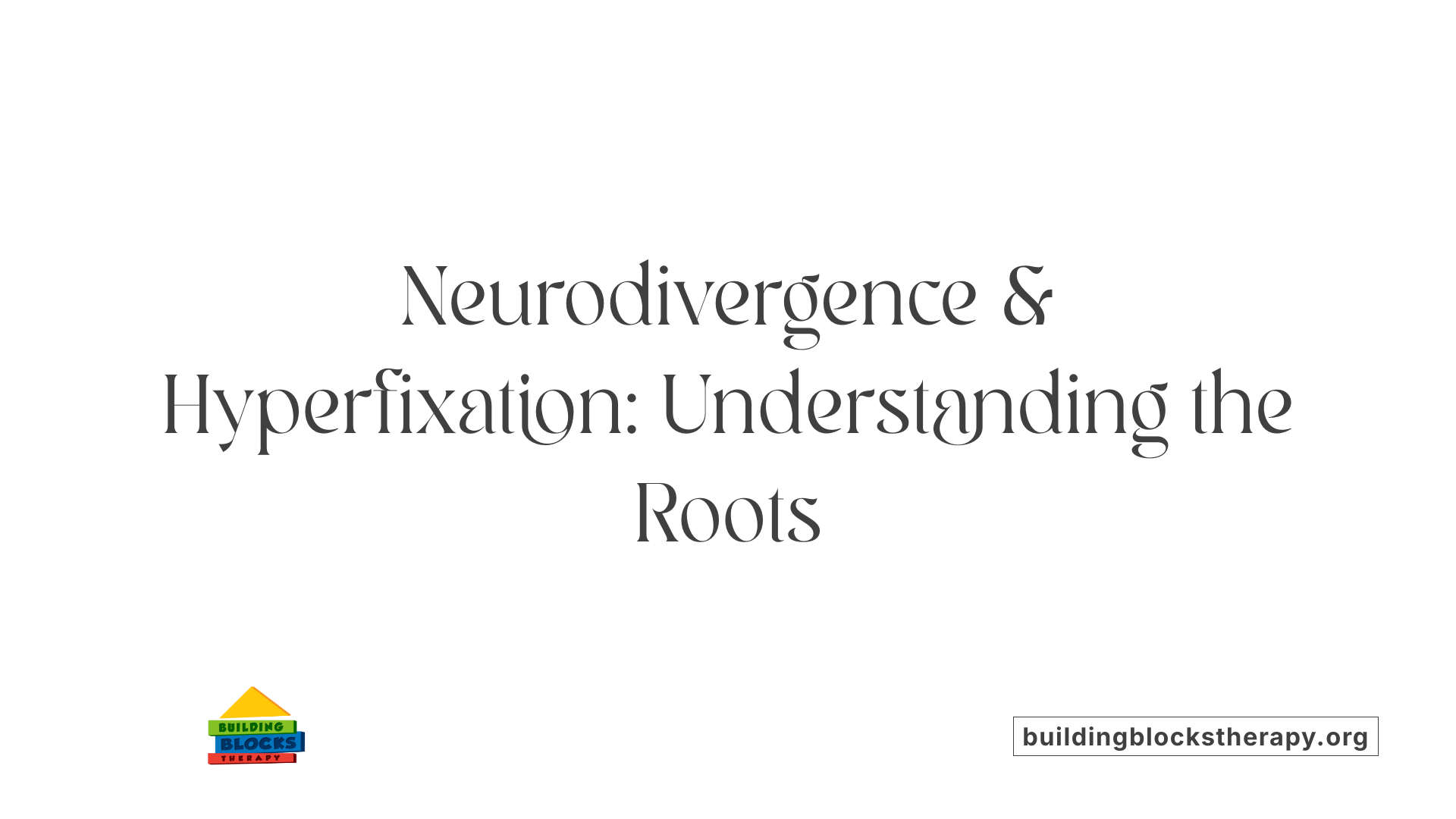
What is the relationship between hyperfixation and neurodivergent conditions like ADHD, autism, and OCD?
Hyperfixation is an intense, long-lasting concentration on a particular object, activity, or topic that often causes individuals to disregard other responsibilities. It is frequently seen in neurodivergent groups, especially in conditions like ADHD, autism spectrum disorder (ASD), and obsessive-compulsive disorder (OCD).
In autism, hyperfixation manifests as 'special interests,' which are deep, focused pursuits that can span years. These interests often provide comfort, help in managing sensory overload, and offer a way to process information. For individuals with ADHD, hyperfixation is usually driven by dopamine dysregulation, leading to deep focus on stimulating or rewarding activities. They might lose track of time and neglect other tasks when hyperfixated.
OCD-related hyperfixations involve intrusive, distressing thoughts or compulsive behaviors intended to reduce anxiety. Unlike typical hyperfixations, OCD obsessions are unwanted and often cause significant stress.
While hyperfixation can lead to mastery and creativity, it can also interfere with daily functionality. People might forget to eat, ignore communication, or neglect personal needs. Managing hyperfixation often includes setting boundaries, seeking support, and establishing routines that balance focus with responsibilities.
Neurological and psychological causes
The roots of hyperfixation are linked to complex neurological and psychological factors. In conditions like ADHD, neural pathways involved in attention regulation and reward processing are affected, particularly those related to dopamine. This neurochemical imbalance causes heightened focus on certain stimuli as a form of dopamine chasing.
In autism, differences in brain connectivity and sensory processing contribute to the development of intense interests. These special interests are highly rewarding and can serve as coping mechanisms.
Psychologically, hyperfixation can also act as an emotional regulation tool — helping individuals manage anxiety, trauma, or stress by immersing themselves deeply in a comforting activity.
The role of dopamine and emotional regulation
Dopamine, known as the 'feel-good' neurotransmitter, plays a crucial role in hyperfixation. In ADHD, lower dopamine levels make tasks that offer quick rewards or stimulation highly appealing, leading to prolonged focus on those activities.
For individuals with autism, the neural pathways may produce heightened responses to specific interests, reinforcing their intense focus.
Emotionally, hyperfixation can serve as a self-soothing process, providing control and predictability amid chaos or emotional distress. However, when this focus becomes overwhelming or persistent to the point of neglecting other aspects of life, it can be necessary to seek professional strategies to maintain a healthy balance.
| Condition | Typical Manifestation | Duration | Underlying Neurobiology |
|---|---|---|---|
| ADHD | Intensive pursuit of stimulating activities | Minutes to months | Dopamine dysregulation |
| Autism Spectrum Disorder | Focused interests or 'special interests' | Months to years | Differences in connectivity, sensory processing |
| OCD | Intrusive thoughts and compulsive behaviors | Varies, often distressing | Anxiety-driven, intrusive thoughts |
Understanding these neurological and emotional factors helps tailor supportive strategies to manage hyperfixation consciously. Ultimately, when guided well, hyperfixation can be a powerful tool for skill development and emotional resilience.
Causes, Symptoms, and Manifestations of Hyperfixation

What causes hyperfixation, and what are its typical symptoms and manifestations?
Hyperfixation stems from a combination of neurological and emotional factors. Neurologically, it is often linked to dopamine dysregulation, which affects how the brain processes reward and attention. This dysregulation makes individuals more prone to intense focus on activities or interests that are perceived as highly rewarding or stimulating.
People with neurodivergent conditions such as ADHD and autism spectrum disorder (ASD) are especially likely to experience hyperfixation. In ADHD, the issue often relates to their brain’s difficulty in regulating dopamine levels, leading to a state of hyperfocus on tasks that seem engaging or rewarding. For those with autism, hyperfixation typically appears as 'special interests,' which involve deep and prolonged focus on specific topics.
Beyond neurodivergence, hyperfixation can also emerge as a coping mechanism in response to stress, trauma, anxiety, or depression. It functions as a way to find comfort or gain a sense of control during emotional upheaval.
The primary symptoms of hyperfixation include a persistent and intense focus that causes the individual to lose track of time, ignore surroundings, and neglect basic needs like eating and sleeping. It often involves an emotional surge, such as excitement or irritability, and a narrowed focus that makes it difficult to switch attention to other tasks or responsibilities.
Individuals may become completely absorbed in their activity or interest, sometimes to the point of obsession. This can lead to social withdrawal, disorganization, and a neglect of personal care. Hyperfixations can last from a few minutes to several months or even years, depending on the individual and the context.
While hyperfixation can foster deep learning, skill development, and creative problem-solving, it can also be disruptive. If it interferes with daily responsibilities or emotional well-being, managing it with strategies like setting time limits, incorporating breaks, and seeking professional support is advisable.
In summary, hyperfixation is a complex phenomenon influenced by brain chemistry and emotional states. Its symptoms range from lost time and neglected responsibilities to emotional intensity, and its persistence makes it both a potential asset and a challenge in daily life.
Impacts of Hyperfixation on Daily Life

How does hyperfixation affect responsibilities, relationships, and health?
Hyperfixation can have profound effects on an individual's daily responsibilities, social relationships, and physical and mental health. When someone becomes deeply engrossed in an activity, they often forget basic needs like eating, sleeping, or attending to personal hygiene. This neglect can lead to physical health issues such as fatigue, dehydration, or nutritional deficiencies.
In terms of relationships, hyperfixation may cause social withdrawal or neglect of loved ones, leading to misunderstandings, feelings of neglect, or conflict. The obsessive focus on a particular interest or activity can also make it difficult to engage in conversations or social outings, further isolating the individual.
From a mental health perspective, hyperfixation can intensify feelings of frustration or guilt when interrupted. It may also contribute to emotional exhaustion, burnout, or increased anxiety, especially if the fixation causes neglect of scheduled responsibilities or social commitments.
What are some positive aspects and opportunities linked to hyperfixation?
Despite its challenges, hyperfixation can offer significant benefits. When channeled effectively, it can lead to rapid skill development, enhanced creativity, and deep mastery of a subject. For neurodivergent individuals, such intense focus can serve as a source of joy, purpose, and self-esteem.
Additionally, hyperfixation may foster meaningful social connections, particularly in shared interests such as hobbies or niche topics. This can boost confidence and improve communication skills within like-minded communities.
Furthermore, the repetitive engagement with a subject often enhances concentration and problem-solving abilities—traits valuable in educational and professional settings.
What are the negative consequences and challenges of hyperfixation?
On the flip side, hyperfixation can lead to considerable difficulties in daily life. Over-immersion in one activity often results in neglecting essential tasks, which may cause missed deadlines, unfinished projects, or health issues.
It can also impair emotional regulation, leading to increased irritability, guilt, or shame after hyperfixation subsides. The inability to switch focus or disengage can result in frustration and interfere with routine activities.
Relationships may suffer as loved ones feel ignored or undervalued, which can cause emotional strain and social isolation.
To avoid or reduce these negative effects, many individuals benefit from adopting management techniques. These include setting clear time limits, scheduling breaks, and working with mental health professionals to develop healthier habits. Recognizing hyperfixation as both a potential strength and a challenge allows individuals to better balance their interests with daily responsibilities, enhancing overall well-being.
Coping Strategies and Managing Hyperfixation
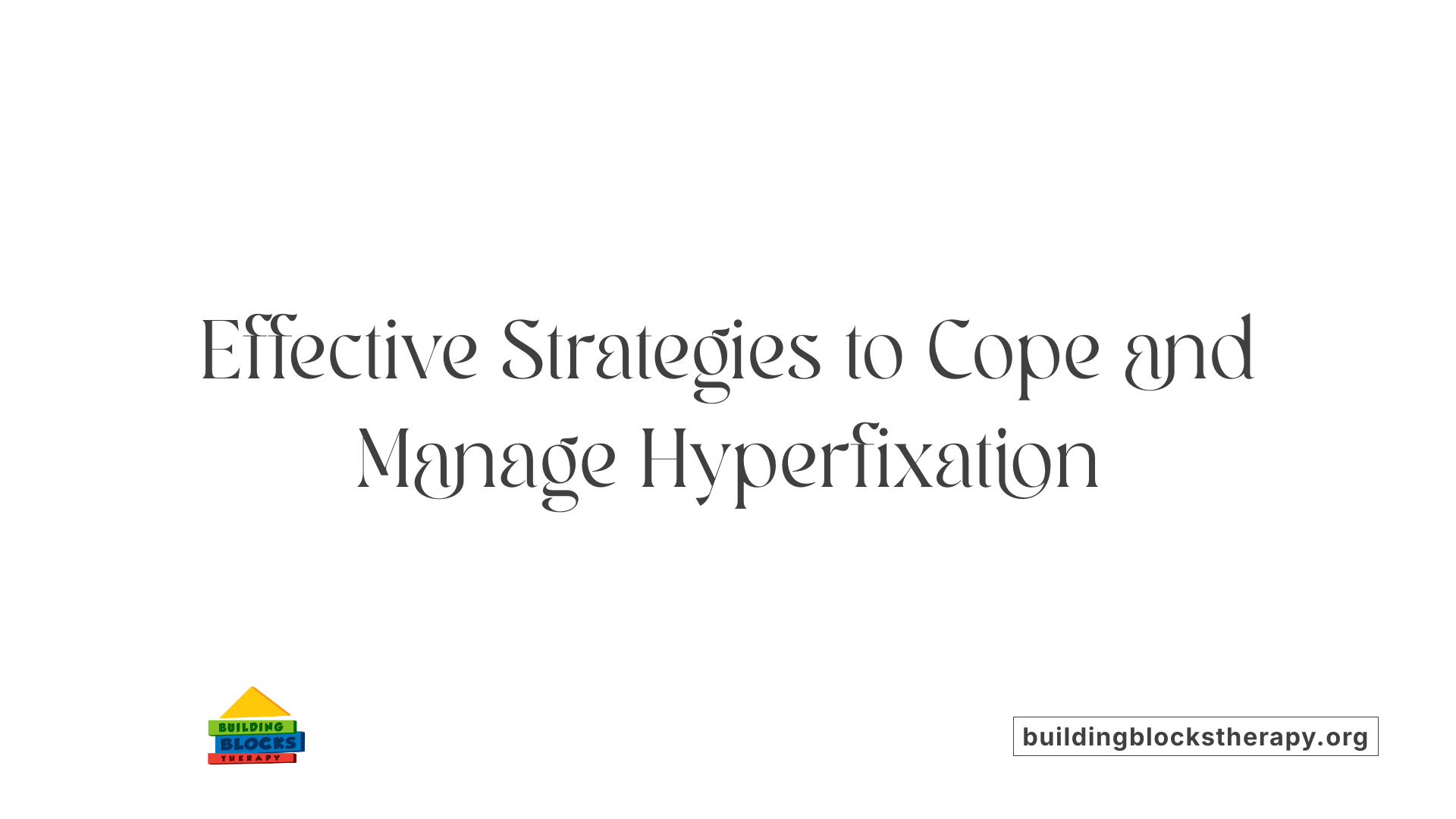
How can individuals manage or cope with hyperfixation?
Managing hyperfixation effectively involves a combination of practical tools and self-awareness. One of the most straightforward strategies is setting clear boundaries around the time spent on a particular activity. Using timers or scheduling designated periods for different tasks can help prevent hyperfixation from taking over an entire day, ensuring that other responsibilities and needs are not neglected.
In addition to time management tools, practicing mindfulness techniques can increase awareness of hyperfixation episodes. Mindfulness allows individuals to notice when they are becoming intensely absorbed and to consciously shift their focus to other activities or responsibilities. This practice fosters greater control and encourages healthier transitions between interests.
Creating a balanced routine that incorporates a variety of activities can also mitigate the negative effects of hyperfixation. Diversifying interests and including social interactions, physical activities, and self-care helps maintain overall well-being and reduces the likelihood of neglecting essential needs.
Seeking professional support is highly recommended, especially when hyperfixation causes significant distress or impairment. Therapies like cognitive-behavioral therapy (CBT) can offer tailored strategies to understand underlying causes, such as emotional regulation issues or neurobiological factors, and develop healthy coping mechanisms.
Another vital aspect is fostering self-awareness and practicing self-care. Recognizing early signs of hyperfixation enables individuals to take proactive steps to manage their focus. Maintaining social connections and exploring new interests can also balance out intense engagements, ensuring hyperfixation remains a constructive and enriching part of life rather than a disruptive one.
In summary, managing hyperfixation involves a mix of structured planning, professional guidance, and personal mindfulness. These approaches create a healthier relationship with intense interests, allowing individuals to enjoy their passions while maintaining functioning in daily life.
The Role of Self-Compassion and Support Systems
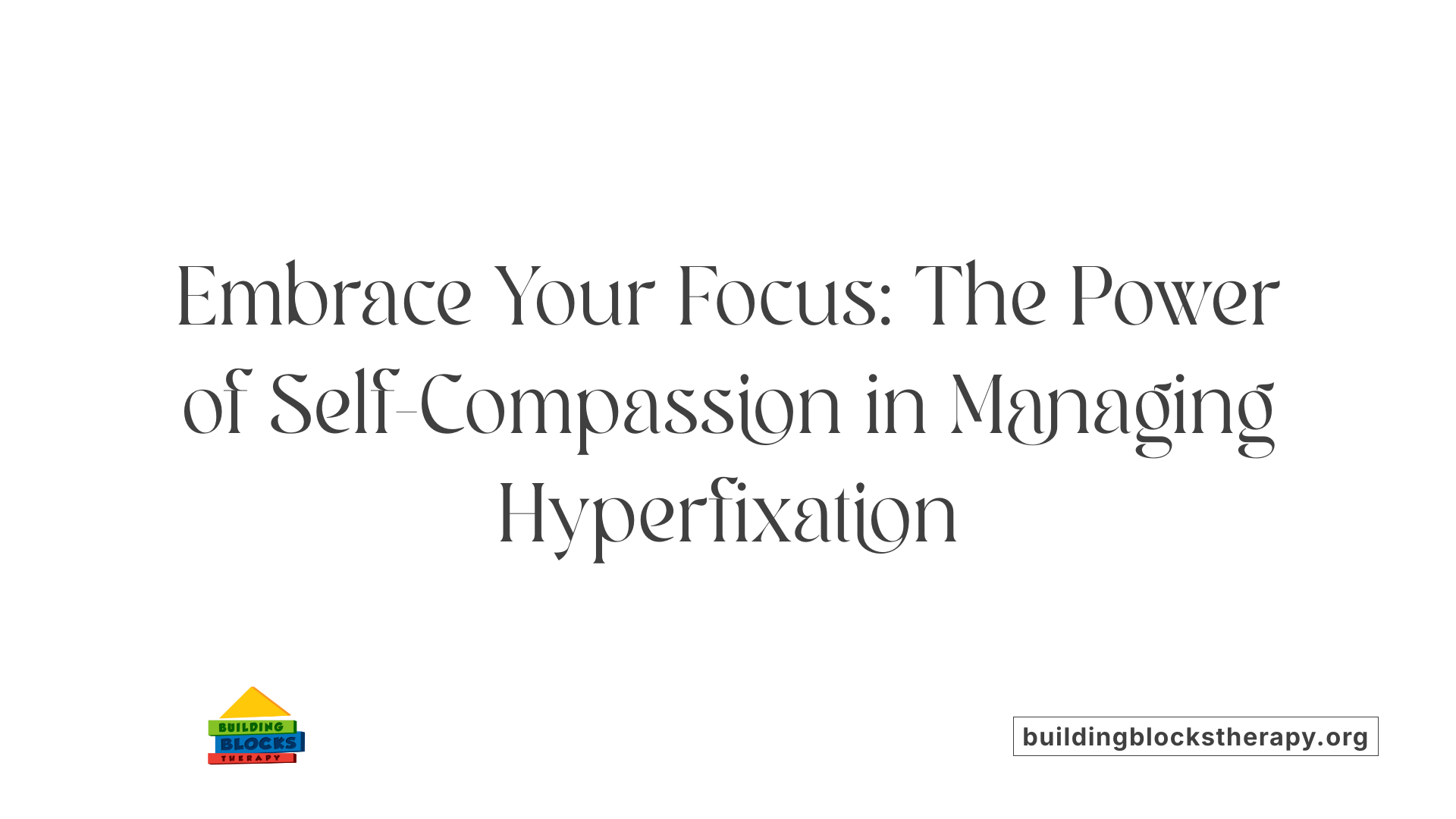
Importance of self-kindness
Managing hyperfixation healthily starts with practicing self-compassion. It’s essential to accept periods of intense focus without guilt, recognizing that hyperfixation can be both a source of strength and challenge. Being kind to yourself means understanding that fluctuations in focus and engagement are natural, especially for neurodivergent individuals. Instead of criticizing yourself for becoming deeply absorbed in an activity, appreciate the passion and skills it fosters.
Building a support network
Having a reliable support network is instrumental in maintaining a balanced approach to hyperfixation. Friends, family, or support groups can offer emotional encouragement and hold you accountable. Sharing your experiences and setting boundaries together can help prevent hyperfixation from negatively impacting your responsibilities. Support systems also provide a safe space for expressing feelings of frustration, guilt, or exhaustion related to hyperfixation.
Utilizing therapy and community resources
Professional help, such as therapy or counseling, can provide tailored strategies to manage hyperfixation effectively. Therapists can teach techniques like mindfulness, time management, and sensory regulation that help balance passions with daily needs. Additionally, community resources—educational programs, mental health services, and peer-led groups—offer valuable tools and shared experiences that foster resilience. These resources can guide individuals in developing coping mechanisms, promoting emotional well-being, and ensuring hyperfixation remains a positive, enriching aspect of life.
By fostering self-kindness, building robust support systems, and utilizing available professional and community help, individuals can navigate hyperfixation in a way that enhances their quality of life and personal growth.
Summary and Final Thoughts on Hyperfixation
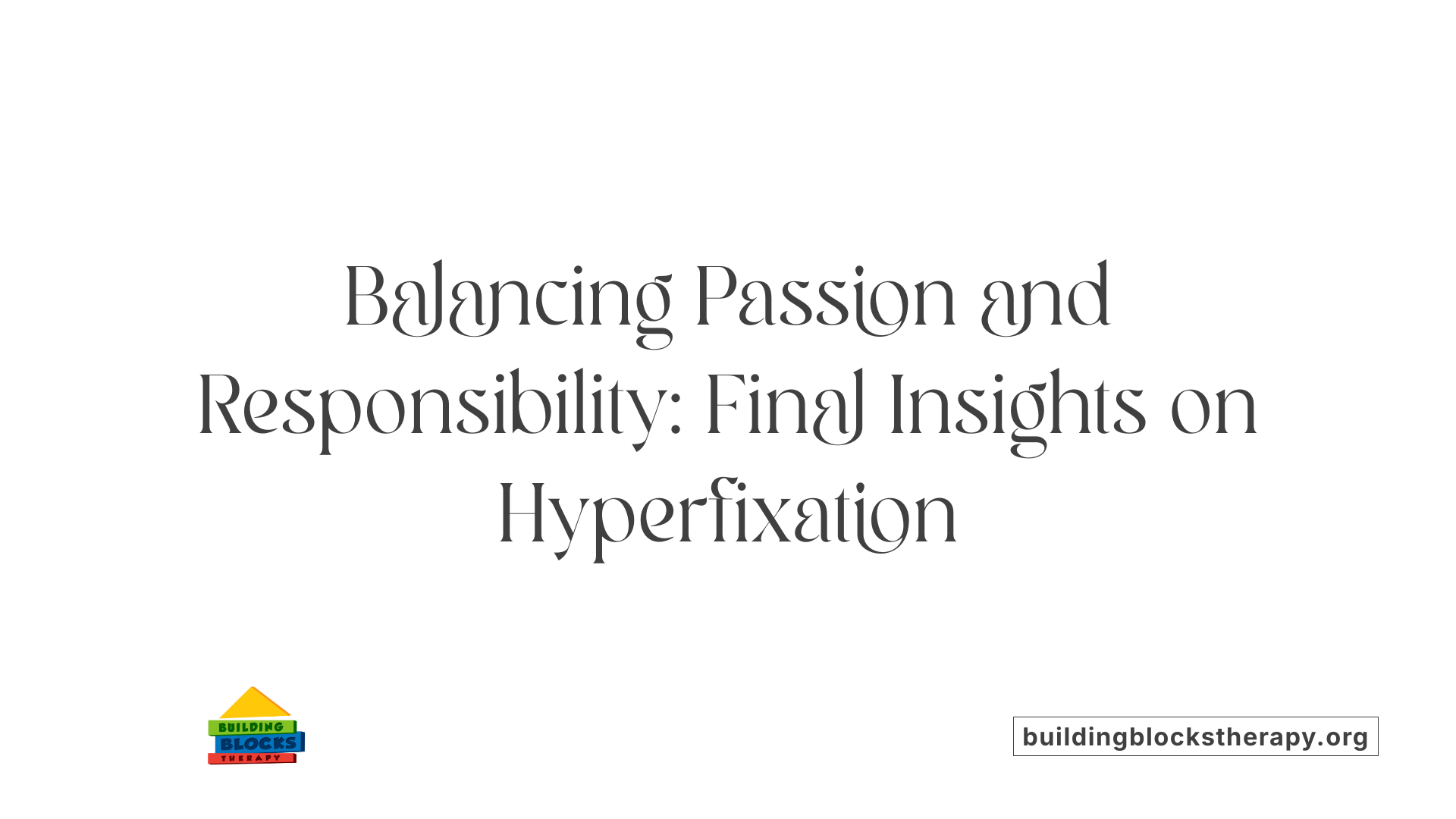
Recap of key points
Hyperfixation is a powerful state of deep absorption in a task, activity, or interest that can last from minutes to months. It is common among neurodivergent individuals, especially those with ADHD and autism spectrum disorder, though it can also occur in neurotypical people. Symptoms include losing track of time, neglecting basic needs, ignoring surroundings, and difficulty transitioning away from the fixation. While hyperfixation can enhance skills, creativity, and mood, it may also lead to neglect of responsibilities, social withdrawal, and emotional distress if unmanaged.
The causes of hyperfixation are diverse, ranging from neurobiological factors like dopamine dysregulation to emotional responses such as seeking control or escapism. It often provides comfort and a sense of mastery but can interfere with daily routines and wellbeing. Management involves setting boundaries, scheduling breaks, seeking support from mental health professionals, and using organizational tools.
Understanding the distinction between hyperfixation and related phenomena like obsession or special interests is important. Hyperfixations are generally voluntary and enjoyable, whereas obsessions tend to be unwanted, distressing, and anxiety-driven.
Balancing focus with responsibilities
Achieving a healthy balance involves self-awareness and deliberate strategies. It is helpful to set time limits using timers or alarms and to prioritize responsibilities by creating structured routines. Engaging in diverse activities can prevent overreliance on a single fixation, and practicing mindfulness techniques helps in transitioning between interests.
Support networks and therapy, such as cognitive-behavioral therapy (CBT), are valuable for developing coping skills and resilience. Physical and social boundaries can prevent hyperfixations from becoming overwhelming. Self-compassion is essential, recognizing that hyperfixation often stems from complex neurobiological and emotional factors rather than laziness or lack of will.
Future outlook and research directions
Further research is needed to better understand the neurobiological mechanisms behind hyperfixation, especially in relation to dopamine regulation and brain connectivity patterns. Exploring how hyperfixation can be harnessed therapeutically—such as in skills development or emotional regulation—may offer new intervention avenues.
Studies focusing on personalized management strategies tailored to individual needs could improve outcomes, particularly in educational and clinical settings. Investigating how hyperfixations evolve over time and their long-term effects on mental health and social integration will also be valuable.
As awareness increases, more effective tools and therapies will likely emerge, helping individuals navigate hyperfixation more healthily and productively. Enhanced understanding might also shed light on the positive potentials of deep focus and passion in fostering lifelong skills and connections.
Balancing Focus and Well-being
Understanding hyperfixation is essential for recognizing its role in mental and neurological health. While it can serve as a powerful tool for learning, creativity, and emotional regulation, unchecked hyperfixation may also lead to significant challenges. Balancing passionate engagement with responsibilities requires self-awareness, structured routines, and support. Continued research and awareness will aid in developing effective management strategies, helping individuals harness the benefits of hyperfixation while minimizing its downsides. Embracing self-compassion and external support systems is vital in fostering a healthy relationship with this complex phenomenon.
References
- What is Hyperfixation? - Charlie Health
- ADHD & Hyperfixation: The Phenomenon of Extreme Focus
- What is hyperfixation? Symptoms, causes, and how to manage it
- Hyperfixation: What It Is & How To Combat Hyperfocusing
- Special Interest vs. Hyperfixation: Differences and Resources
- Understanding Hyperfixation and How to Manage It
- What a Hyperfixation Really Is - Time Magazine






